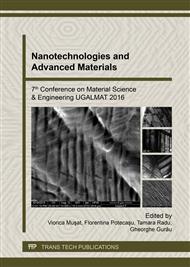p.108
p.114
p.120
p.127
p.133
p.139
p.145
p.154
p.160
Fatigue Life Estimation of a Layered Composite Plate
Abstract:
This paper presents the FEM approach of fatigue life estimation of a layered composite plate having a central elliptical cut-out subjected to time variation loads. Some properties and material data, such as data used for the S-N curve / Wöhler curve of the material, represented in cyclic stress versus number of cycles to failure coordinates, which is required for starting the fatigue analysis, were taken from the OPTIMAT database.The plate analysis was parameterized and modeled with the Shell281 element type. This type of element can be used in a triangular form more efficiently than other types of shell elements available in version 15 of ASYS APDL.Initially, the static analysis was performed to identify the node with the maximum principal stress (hot spots). This node was used for performing the fatigue analysis. The fatigue parameter to estimate fatigue life is cumulative fatigue usage factor. This factor is obtained by adding together all individual usage factors calculated for each variable load that is applied to the analyzed plate. The fatigue usage factor is used to estimate the percentage of life that is consumed after applying the fatigue loads. The value of the usage factor is in the range from 0 to 1.
Info:
Periodical:
Pages:
133-138
Citation:
Online since:
February 2017
Authors:
Price:
Сopyright:
© 2017 Trans Tech Publications Ltd. All Rights Reserved
Share:
Citation:


